Recent Advances in Design Strategies and Imaging Applications of Fluorescent Probes for ATP
Abstract
:1. Introduction
2. The Design Strategy of Fluorescent Probes for ATP
2.1. ATP Fluorescent Probes Based on Organic Small Molecules
2.1.1. ATP Fluorescent Probe Based on the Ring-Opening Reaction
2.1.2. ATP Fluorescent Probe Based on Electrostatic Interaction
2.1.3. ATP Fluorescent Probes Based on Aggregation-Induced Emission
2.2. ATP Fluorescent Probes Based on Metal Complexes
2.2.1. ATP Fluorescent Probes Based on Zinc Complexes
2.2.2. ATP Fluorescent Probes Based on Copper Complexes
2.2.3. ATP Fluorescent Probes Based on Other Metal Complexes
2.3. ATP Fluorescent Probes Based on Water-Soluble Conjugated Polymers
3. Imaging Applications of ATP Fluorescent Probes
3.1. ATP Fluorescent Probes for Targeting Organelles
3.2. ATP Fluorescent Probes for the Imaging of Cell Biological Events
3.3. ATP Fluorescent Probes for the Imaging of Disease Markers
4. Summary and Outlook
Author Contributions
Funding
Institutional Review Board Statement
Informed Consent Statement
Data Availability Statement
Conflicts of Interest
References
- Patel, A.; Malinovska, L.; Saha, S.; Wang, J.; Alberti, S.; Krishnan, Y.; Hyman, A.A. ATP as a biological hydrotrope. Science 2017, 356, 753–756. [Google Scholar] [CrossRef] [PubMed]
- Fields, R.D.; Stevens, B. ATP: An extracellular signaling molecule between neurons and glia. Trends Neurosci. 2000, 23, 625–633. [Google Scholar] [CrossRef] [PubMed]
- Shen, X.; Mizuguchi, G.; Hamiche, A.; Wu, C. A chromatin remodelling complex involved in transcription and DNA processing. Nature 2000, 406, 541–544. [Google Scholar] [CrossRef]
- Xu, Z.; Singh, N.J.; Lim, J.; Pan, J.; Kim, H.N.; Park, S.; Kim, K.S.; Yoon, J. Unique sandwich stacking of pyrene-adenine-pyrene for selective and ratiometric fluorescent sensing of ATP at physiological pH. J. Am. Chem. Soc. 2009, 131, 15528–15533. [Google Scholar] [CrossRef] [PubMed]
- Impellizzeri, F.M.; Marcora, S.M.; Castagna, C.; Reilly, T.; Sassi, A.; Iaia, F.M.; Rampinini, E. Physiological and performance effects of generic versus specific aerobic training in soccer players. Int. J. Sports Med. 2006, 27, 483–492. [Google Scholar] [CrossRef] [Green Version]
- Dennis, P.B.; Jaeschke, A.; Saitoh, M.; Fowler, B.; Kozma, S.C.; Thomas, G. Mammalian TOR: A homeostatic ATP sensor. Science 2001, 294, 1102–1105. [Google Scholar] [CrossRef]
- Ashcroft, F.M.; Gribble, F.M. ATP-sensitive K+ channels and insulin secretion: Their role in health and disease. Diabetologia 1999, 42, 903–919. [Google Scholar] [CrossRef] [Green Version]
- Van Wylen, D.G.; Park, T.S.; Rubio, R.; Berne, R.M. Increases in cerebral interstitial fluid adenosine concentration during hypoxia, local potassium infusion, and ischemia. J. Cereb. Blood Flow Metab. 1986, 6, 522–528. [Google Scholar] [CrossRef] [Green Version]
- Zhu, C.; Zhao, Y.; Yan, M.; Huang, Y.; Yan, J.; Bai, W.; Chen, A. A sandwich dipstick assay for ATP detection based on split aptamer fragments. Anal. Bioanal. Chem. 2016, 408, 4151–4158. [Google Scholar] [CrossRef]
- Sweeney, M.I. Neuroprotective effects of adenosine in cerebral ischemia: Window of opportunity. Neurosci. Biobehav. Rev. 1997, 21, 207–217. [Google Scholar] [CrossRef]
- Bush, K.T.; Keller, S.H.; Nigam, S.K. Genesis and reversal of the ischemic phenotype in epithelial cells. J. Clin. Investig. 2000, 106, 621–626. [Google Scholar] [CrossRef] [PubMed] [Green Version]
- Makela, A.; Kuusi, T.; Schroder, T. Inhibition of serum phospholipase-A2 in acute pancreatitis by pharmacological agents in vitro. Scand. J. Clin. Lab. Investig. 1997, 57, 401–407. [Google Scholar] [CrossRef] [PubMed]
- Cruz-Aguado, J.A.; Chen, Y.; Zhang, Z.; Elowe, N.H.; Brook, M.A.; Brennan, J.D. Ultrasensitive ATP Detection Using Firefly Luciferase Entrapped in Sugar-Modified Sol−Gel-Derived Silica. J. Am. Chem. Soc. 2004, 126, 6878–6879. [Google Scholar] [CrossRef] [PubMed]
- Yu, P.; He, X.; Zhang, L.; Mao, L. Dual recognition unit strategy improves the specificity of the adenosine triphosphate (ATP) aptamer biosensor for cerebral ATP assay. Anal. Chem. 2015, 87, 1373–1380. [Google Scholar] [CrossRef] [PubMed]
- Huang, Y.F.; Chang, H.T. Analysis of adenosine triphosphate and glutathione through gold nanoparticles assisted laser desorption/ionization mass spectrometry. Anal. Chem. 2007, 79, 4852–4859. [Google Scholar] [CrossRef]
- Xie, P.J.; Ye, M.L.; Hu, Z.Y.; Pan, G.W.; Zhu, Y.; Zhang, J.J. Determination of levels of adenosine phosphates in blood by ion chromatography. Chin. Chem. Lett. 2011, 22, 1485–1488. [Google Scholar] [CrossRef]
- Mora, L.; Hernandez-Cazares, A.S.; Aristoy, M.C.; Toldra, F. Hydrophilic interaction chromatographic determination of adenosine triphosphate and its metabolites. Food Chem. 2010, 123, 1282–1288. [Google Scholar] [CrossRef]
- Yang, Y.M.; Zhao, Q.; Feng, W.; Li, F.Y. Luminescent chemodosimeters for bioimaging. Chem. Rev. 2013, 113, 192–270. [Google Scholar] [CrossRef]
- Li, X.; Gao, X.; Shi, W.; Ma, H. Design strategies for water-soluble small molecular chromogenic and fluorogenic probes. Chem. Rev. 2014, 114, 590–659. [Google Scholar] [CrossRef]
- Li, Z.; Liang, T.; Lv, S.W.; Zhuang, Q.G.; Liu, Z.H. A Rationally Designed Upconversion Nanoprobe for in Vivo Detection of Hydroxyl Radical. J. Am. Chem. Soc. 2015, 137, 11179–11185. [Google Scholar] [CrossRef]
- Wu, F.; Liu, J.; Tao, M.; Wang, M.; Ren, X.; Hai, Z. β-Galactosidase-Activatable Fluorescent and Photoacoustic Imaging of Tumor Senescence. Anal. Chem. 2023, 95, 10481–10485. [Google Scholar] [CrossRef] [PubMed]
- Liu, Y.; Zhou, J.; Wang, L.L.; Hu, X.X.; Liu, X.J.; Liu, M.R.; Cao, Z.H.; Shangguan, D.H.; Tan, W.H. A Cyanine Dye to Probe Mitophagy: Simultaneous Detection of Mitochondria and Autolysosomes in Live Cells. J. Am. Chem. Soc. 2016, 138, 12368–12374. [Google Scholar] [CrossRef] [PubMed]
- Zhang, X.F.; Wang, B.L.; Wang, C.; Chen, L.C.; Xiao, Y. Monitoring Lipid Peroxidation within Foam Cells by Lysosome-Targetable and Ratiometric Probe. Anal. Chem. 2015, 87, 8292–8300. [Google Scholar] [CrossRef]
- Mao, Z.Q.; Feng, W.Q.; Li, Z.; Zeng, L.Y.; Lv, W.J.; Liu, Z.H. NIR in, far-red out: Developing a two-photon fluorescent probe for tracking nitric oxide in deep tissue. Chem. Sci. 2016, 7, 5230–5235. [Google Scholar] [CrossRef] [Green Version]
- Liu, Y.C.; Teng, L.L.; Chen, L.L.; Ma, H.C.; Liu, H.W.; Zhang, X.B. Engineering of a near-infrared fluorescent probe for real-time simultaneous visualization of intracellular hypoxia and induced mitophagy. Chem. Sci. 2018, 9, 5347–5353. [Google Scholar] [CrossRef] [Green Version]
- Zhu, B.C.; Li, P.; Shu, W.; Wang, X.; Liu, C.Y.; Wang, Y.; Wang, Z.K.; Wang, Y.W.; Tang, B. Highly Specific and Ultrasensitive Two-Photon Fluorescence Imaging of Native HOCl in Lysosomes and Tissues Based on Thiocarbamate Derivatives. Anal. Chem. 2016, 88, 12532–12538. [Google Scholar] [CrossRef]
- Gao, S.T.; Tang, G.S.; Hua, D.W.; Xiong, R.H.; Han, J.Q.; Jiang, S.H.; Zhang, Q.L.; Huang, C.B. Stimuli-responsive bio-based polymeric systems and their applications. J. Mater. Chem. B 2019, 7, 709–729. [Google Scholar] [CrossRef]
- Yang, G.; Liu, Z.; Zhang, R.; Tian, X.; Chen, J.; Han, G.; Liu, B.; Han, X.; Fu, Y.; Hu, Z.; et al. A Multi-responsive Fluorescent Probe Reveals Mitochondrial Nucleoprotein Dynamics with Reactive Oxygen Species Regulation through Super-resolution Imaging. Angew. Chem. Int. Ed. 2020, 59, 16154–16160. [Google Scholar] [CrossRef] [PubMed]
- Guo, Z.; Song, N.R.; Moon, J.H.; Kim, M.; Jun, E.J.; Choi, J.; Lee, J.Y.; Bielawski, C.W.; Sessler, J.L.; Yoon, J. A Benzobisimidazolium-Based Fluorescent and Colorimetric Chemosensor for CO2. J. Am. Chem. Soc. 2012, 134, 17846–17849. [Google Scholar] [CrossRef] [PubMed]
- Li, D.; Tian, X.; Liu, Z.; Liu, J.; Han, G.; Liu, B.; Zhao, J.; Zhang, R.; Tian, Y.; Zhang, Z. Revealing Sulfur Dioxide Regulation to Nucleophagy in Embryo Development by an Adaptive Coloration Probe. Anal. Chem. 2021, 93, 13667–13672. [Google Scholar] [CrossRef]
- Yan, C.; Guo, Z.; Liu, Y.; Shi, P.; Tian, H.; Zhu, W.H. A sequence-activated AND logic dual-channel fluorescent probe for tracking programmable drug release. Chem. Sci. 2018, 9, 6176–6182. [Google Scholar] [CrossRef] [Green Version]
- Yuan, L.; Lin, W.; Zheng, K.; He, L.; Huang, W. Far-red to near infrared analyte-responsive fluorescent probes based on organic fluorophore platforms for fluorescence imaging. Chem. Soc. Rev. 2013, 42, 622–661. [Google Scholar] [CrossRef] [PubMed]
- Weissleder, R. A clearer vision for in vivo imaging. Nat. Biotechnol. 2001, 19, 316–317. [Google Scholar] [CrossRef]
- Bu, Y.; Zhu, X.; Wang, H.; Zhang, J.; Wang, L.; Yu, Z.; Tian, Y.; Zhou, H.; Xie, Y. Self-Monitoring the Endo-Lysosomal Escape and Near-Infrared-Activated Mitophagy To Guide Synergistic Type-I Photodynamic and Photothermal Therapy. Anal. Chem. 2021, 93, 12059–12066. [Google Scholar] [CrossRef]
- Kang, Z.; Wu, Q.; Guo, X.; Wang, L.; Ye, Y.; Yu, C.; Wang, H.; Hao, E.; Jiao, L. FeCl3-promoted regioselective synthesis of BODIPY dimers through oxidative aromatic homocoupling reactions. Chem. Commun. 2021, 57, 9886–9889. [Google Scholar] [CrossRef]
- Wang, T.; Wang, S.; Liu, Z.; He, Z.; Yu, P.; Zhao, M.; Zhang, H.; Lu, L.; Wang, Z.; Wang, Z.; et al. A hybrid erbium(III)-bacteriochlorin near-infrared probe for multiplexed biomedical imaging. Nat. Mater. 2021, 20, 1571–1578. [Google Scholar] [CrossRef] [PubMed]
- Yang, Q.; Jia, C.; Chen, Q.; Du, W.; Wang, Y.; Zhang, Q. A NIR fluorescent probe for the detection of fluoride ions and its application in in vivo bioimaging. J. Mater. Chem. B 2017, 5, 2002–2009. [Google Scholar] [CrossRef]
- Zhao, X.; Yao, Q.; Long, S.; Chi, W.; Yang, Y.; Tan, D.; Liu, X.; Huang, H.; Sun, W.; Du, J.; et al. An Approach to Developing Cyanines with Simultaneous Intersystem Crossing Enhancement and Excited-State Lifetime Elongation for Photodynamic Antitumor Metastasis. J. Am. Chem. Soc. 2021, 143, 12345–12354. [Google Scholar] [CrossRef] [PubMed]
- Li, H.D.; Yao, Q.C.; Fan, J.L.; Du, J.J.; Wang, J.Y.; Peng, X.J. An NIR fluorescent probe of uric HSA for renal diseases warning. Dye. Pigment. 2016, 133, 79–85. [Google Scholar] [CrossRef]
- Luo, X.; Wang, R.; Lv, C.; Chen, G.; You, J.; Yu, F. Detection of Selenocysteine with a Ratiometric near-Infrared Fluorescent Probe in Cells and in Mice Thyroid Diseases Model. Anal. Chem. 2020, 92, 1589–1597. [Google Scholar] [CrossRef]
- Yu, W.; Huang, J.; Lin, M.; Wei, G.; Yang, F.; Tang, Z.; Zeng, F.; Wu, S. Fluorophore-Dapagliflozin Dyad for Detecting Diabetic Liver/Kidney Damages via Fluorescent Imaging and Treating Diabetes via Inhibiting SGLT2. Anal. Chem. 2021, 93, 4647–4656. [Google Scholar] [CrossRef] [PubMed]
- Zhou, K.Y.; Yang, Y.T.; Zhou, T.T.; Jin, M.; Yin, C.X. Design strategy of multifunctional and high efficient hydrogen sulfide NIR fluorescent probe and its application in vivo. Dye. Pigment. 2021, 185, 108901. [Google Scholar] [CrossRef]
- Zhou, E.; Gong, S.; Xia, Q.; Feng, G. In Vivo Imaging and Tracking Carbon Monoxide-Releasing Molecule-3 with an NIR Fluorescent Probe. ACS Sens. 2021, 6, 1312–1320. [Google Scholar] [CrossRef] [PubMed]
- Zeng, Z.; Ouyang, J.; Sun, L.; Zeng, C.; Zeng, F.; Wu, S. Activatable Nanocomposite Probe for Preoperative Location and Intraoperative Navigation for Orthotopic Hepatic Tumor Resection via MSOT and Aggregation-Induced Near-IR-I/II Fluorescence Imaging. Anal. Chem. 2020, 92, 9257–9264. [Google Scholar] [CrossRef]
- Jun, Y.W.; Sarkar, S.; Kim, K.H.; Ahn, K.H. Molecular Probes for Fluorescence Imaging of ATP in Cells and Tissues. ChemPhotoChem 2019, 3, 214–219. [Google Scholar] [CrossRef]
- Huang, B.; Liang, B.; Zhang, R.; Xing, D. Molecule fluorescent probes for adenosine triphosphate imaging in cancer cells and in vivo. Coord. Chem. Rev. 2022, 452, 214302. [Google Scholar] [CrossRef]
- Sun, W.; Gu, X.; Dong, P.; Chu, L.; Zhang, Z.; Cheng, Z.; Yang, F. Cell-membrane-targeted near-infrared fluorescent probe for detecting extracellular ATP. Analyst 2022, 147, 4167–4173. [Google Scholar] [CrossRef]
- Yang, B.; Qu, W.; Guo, T.; Tian, R.; Qiu, S.; Chen, X.; Geng, Z.; Wang, Z. Tetraphenylethylene fluorophore based AIE-fluorescent probe for detection of ATP in mitochondria. Dye. Pigment. 2023, 215, 111295. [Google Scholar] [CrossRef]
- Beija, M.; Afonso, C.A.; Martinho, J.M. Synthesis and applications of Rhodamine derivatives as fluorescent probes. Chem. Soc. Rev. 2009, 38, 2410–2433. [Google Scholar] [CrossRef] [Green Version]
- Chen, X.; Pradhan, T.; Wang, F.; Kim, J.S.; Yoon, J. Fluorescent chemosensors based on spiroring-opening of xanthenes and related derivatives. Chem. Rev. 2012, 112, 1910–1956. [Google Scholar] [CrossRef]
- Li, C.Y.; Zou, C.X.; Li, Y.F.; Kong, X.F.; Zhou, Y.; Wu, Y.S.; Zhu, W.G. A colormetric and fluorescent chemosensor for adenosine-5′-triphosphate based on rhodamine derivative. Anal. Chim. Acta 2013, 795, 69–74. [Google Scholar] [CrossRef]
- Tang, J.L.; Li, C.Y.; Li, Y.F.; Zou, C.X. A ratiometric fluorescent probe with unexpected high selectivity for ATP and its application in cell imaging. Chem. Commun. 2014, 50, 15411–15414. [Google Scholar] [CrossRef] [PubMed]
- Ren, T.B.; Wen, S.Y.; Wang, L.; Lu, P.; Xiong, B.; Yuan, L.; Zhang, X.B. Engineering a Reversible Fluorescent Probe for Real-Time Live-Cell Imaging and Quantification of Mitochondrial ATP. Anal. Chem. 2020, 92, 4681–4688. [Google Scholar] [CrossRef]
- Liu, X.; Gong, X.; Yuan, J.; Fan, X.; Zhang, X.; Ren, T.; Yang, S.; Yang, R.; Yuan, L.; Zhang, X.B. Dual-Stimulus Responsive Near-Infrared Reversible Ratiometric Fluorescent and Photoacoustic Probe for In Vivo Tumor Imaging. Anal. Chem. 2021, 93, 5420–5429. [Google Scholar] [CrossRef]
- Xu, Z.; Song, N.R.; Moon, J.H.; Lee, J.Y.; Yoon, J. Bis- and tris-naphthoimidazolium derivatives for the fluorescent recognition of ATP and GTP in 100% aqueous solution. Org. Biomol. Chem. 2011, 9, 8340–8345. [Google Scholar] [CrossRef]
- Srivastava, P.; Razi, S.S.; Ali, R.; Srivastav, S.; Patnaik, S.; Srikrishna, S.; Misra, A. Highly sensitive cell imaging “Off-On” fluorescent probe for mitochondria and ATP. Biosens. Bioelectron. 2015, 69, 179–185. [Google Scholar] [CrossRef]
- Ghosh, K.; Tarafdar, D.; Samadder, A.; Khuda-Bukhsh, A.R. Pyridinum-based flexible tripodal cleft: A case of fluorescence sensing of ATP and dihydrogenphosphate under different conditions and cell imaging. RSC Adv. 2015, 5, 35175–35180. [Google Scholar] [CrossRef]
- Maity, D.; Li, M.; Ehlers, M.; Gigante, A.; Schmuck, C. A metal-free fluorescence turn-on molecular probe for detection of nucleoside triphosphates. Chem. Commun. 2016, 53, 208–211. [Google Scholar] [CrossRef] [PubMed]
- Noguchi, T.; Shiraki, T.; Dawn, A.; Tsuchiya, Y.; Lien, L.T.N.; Yamamoto, T.; Shinkai, S. Nonlinear fluorescence response driven by ATP-induced self-assembly of guanidinium-tethered tetraphenylethene. Chem. Commun. 2012, 48, 8090–8092. [Google Scholar] [CrossRef] [PubMed]
- Deng, T.; Chen, J.H.; Yu, H.; Yang, P.; Jian, Y.; Li, G.; Zhou, X.; Shen, H.Y.; Gui, J.Z. Adenosine triphosphate-selective fluorescent turn-on response of a novel thiazole orange derivative via their cooperative co-assembly. Sens. Actuators B 2015, 209, 735–743. [Google Scholar] [CrossRef]
- Jiang, G.; Zhu, W.; Chen, Q.; Shi, A.; Wu, Y.; Zhang, G.; Li, X.; Li, Y.; Fan, X.; Wang, J. A new tetraphenylethylene based AIE sensor with light-up and tunable measuring range for adenosine triphosphate in aqueous solution and in living cells. Analyst 2017, 142, 4388–4392. [Google Scholar] [CrossRef] [PubMed]
- Ma, H.; Yang, M.; Zhang, C.; Ma, Y.; Qin, Y.; Lei, Z.; Chang, L.; Lei, L.; Wang, T.; Yang, Y. Aggregation-induced emission (AIE)-active fluorescent probes with multiple binding sites toward ATP sensing and live cell imaging. J. Mater. Chem. B 2017, 5, 8525–8531. [Google Scholar] [CrossRef]
- Ngo, H.T.; Liu, X.; Jolliffe, K.A. Anion recognition and sensing with Zn(II)-dipicolylamine complexes. Chem. Soc. Rev. 2012, 41, 4928–4965. [Google Scholar] [CrossRef] [PubMed]
- Ojida, A.; Park, S.-k.; Mito-oka, Y.; Hamachi, I. Efficient fluorescent ATP-sensing based on coordination chemistry under aqueous neutral conditions. Tetrahedron Lett. 2002, 43, 6193–6195. [Google Scholar] [CrossRef]
- Ojida, A.; Takashima, I.; Kohira, T.; Nonaka, H.; Hamachi, I. Turn-on fluorescence sensing of nucleoside polyphosphates using a xanthene-based Zn(II) complex chemosensor. J. Am. Chem. Soc. 2008, 130, 12095–12101. [Google Scholar] [CrossRef] [PubMed]
- Kurishita, Y.; Kohira, T.; Ojida, A.; Hamachi, I. Rational design of FRET-based ratiometric chemosensors for in vitro and in cell fluorescence analyses of nucleoside polyphosphates. J. Am. Chem. Soc. 2010, 132, 13290–13299. [Google Scholar] [CrossRef]
- Yan, L.W.; Ye, Z.B.; Peng, C.X.; Zhang, S.H. A new perylene diimide-based fluorescent chemosensor for selective detection of ATP in aqueous solution. Tetrahedron 2012, 68, 2725–2727. [Google Scholar] [CrossRef]
- Singh, H.; Sreedharan, S.; Tiwari, R.; Walther, C.; Smythe, C.; Pramanik, S.K.; Thomas, J.A.; Das, A. A Fluorescent Chemodosimeter for Organelle-Specific Imaging of Nucleoside Polyphosphate Dynamics in Living Cells. Cryst. Growth Des. 2018, 18, 7199–7206. [Google Scholar] [CrossRef]
- Jin, X.L.; Wu, X.L.; Wang, B.; Xie, P.; He, Y.L.; Zhou, H.W.; Yan, B.; Yang, J.J.; Chen, W.X.; Zhang, X.H. A reversible fluorescent probe for Zn2+ and ATP in living cells and in vivo. Sens. Actuators B 2018, 261, 127–134. [Google Scholar] [CrossRef]
- Marbumrung, S.; Wongravee, K.; Ruangpornvisuti, V.; Tumcharern, G.; Tuntulani, T.; Tomapatanaget, B. Discrimination of nucleotides by single fluorescence sensor under solvent-dependent recognition patterns. Sens. Actuators B 2012, 171, 969–975. [Google Scholar] [CrossRef]
- Xu, Q.C.; Lv, H.J.; Lv, Z.Q.; Liu, M.; Li, Y.J.; Wang, X.F.; Zhang, Y.; Xing, G.W. A pyrene-functionalized Zinc(II)-BPEA complex: Sensing and discrimination of ATP, ADP and AMP. RSC Adv. 2014, 4, 47788–47792. [Google Scholar] [CrossRef]
- Amendola, V.; Bergamaschi, G.; Buttafava, A.; Fabbrizzi, L.; Monzani, E. Recognition and sensing of nucleoside monophosphates by a dicopper(II) cryptate. J. Am. Chem. Soc. 2010, 132, 147–156. [Google Scholar] [CrossRef] [PubMed]
- Gao, Y.G.; Tang, Q.; Shi, Y.D.; Zhang, Y.; Lu, Z.L. 1,8-naphthalimide modified [12]aneN(3) compounds as selective and sensitive probes for Cu2+ ions and ATP in aqueous solution and living cells. Talanta 2016, 152, 438–446. [Google Scholar] [CrossRef]
- Andrushchenko, V.; Bour, P. Infrared absorption detection of metal ion-deoxyguanosine monophosphate binding: Experimental and theoretical study. J. Phys. Chem. B 2009, 113, 283–291. [Google Scholar] [CrossRef] [Green Version]
- Nair, A.K.; Neelakandan, P.P.; Ramaiah, D. A supramolecular Cu(II) metallocyclophane probe for guanosine 5′-monophosphate. Chem. Commun. 2009, 42, 6352–6354. [Google Scholar] [CrossRef]
- Santangelo, M.G.; Medina-Molner, A.; Schweiger, A.; Mitrikas, G.; Spingler, B. Structural analysis of Cu(II) ligation to the 5′-GMP nucleotide by pulse EPR spectroscopy. JBIC J. Biol. Inorg. Chem. 2007, 12, 767–775. [Google Scholar] [CrossRef] [Green Version]
- Jin, X.; Gao, J.; Xie, P.; Yu, M.; Wang, T.; Zhou, H.; Ma, A.; Wang, Q.; Leng, X.; Zhang, X. Dual-functional probe based on rhodamine for sequential Cu(2+) and ATP detection in vivo. Spectrochim. Acta Part A 2018, 204, 657–664. [Google Scholar] [CrossRef]
- Jin, X.L.; Wu, X.L.; Zhang, F.; Zhao, H.Q.; Zhong, W.; Cao, Y.X.; Ma, X.H.; Leng, X.; Zhou, H.W.; She, M.Y. Cu2+/ATP reversible ratiometric fluorescent probe through strip, hydrogel, and nanofiber, and its application in living cells and edaphic ecological safety assessment. Dye. Pigment. 2020, 182, 108677. [Google Scholar] [CrossRef]
- Xiao, L.; Sun, S.; Pei, Z.; Pei, Y.; Pang, Y.; Xu, Y. A Ga(3+)self-assembled fluorescent probe for ATP imaging in vivo. Biosens. Bioelectron. 2015, 65, 166–170. [Google Scholar] [CrossRef] [PubMed]
- Zhang, X.; Jiang, Y.; Xiao, N. Monitoring ADP and ATP in vivo using a fluorescent Ga(iii)-probe complex. Chem. Commun. 2018, 54, 12812–12815. [Google Scholar] [CrossRef] [PubMed]
- Liu, X.; Xu, J.; Lv, Y.; Wu, W.; Liu, W.; Tang, Y. An ATP-selective, lanthanide complex luminescent probe. Dalton Trans. 2013, 42, 9840–9846. [Google Scholar] [CrossRef] [PubMed]
- Mailhot, R.; Traviss-Pollard, T.; Pal, R.; Butler, S.J. Cationic Europium Complexes for Visualizing Fluctuations in Mitochondrial ATP Levels in Living Cells. Chemistry 2018, 24, 10745–10755. [Google Scholar] [CrossRef] [PubMed] [Green Version]
- Ho, H.A.; Najari, A.; Leclerc, M. Optical detection of DNA and proteins with cationic polythiophenes. Acc. Chem. Res. 2008, 41, 168–178. [Google Scholar] [CrossRef] [PubMed]
- Li, C.; Numata, M.; Takeuchi, M.; Shinkai, S. A sensitive colorimetric and fluorescent probe based on a polythiophene derivative for the detection of ATP. Angew. Chem. Int. Ed. 2005, 44, 6371–6374. [Google Scholar] [CrossRef]
- Huang, B.H.; Geng, Z.R.; Ma, X.Y.; Zhang, C.; Zhang, Z.Y.; Wang, Z.L. Lysosomal ATP imaging in living cells by a water-soluble cationic polythiophene derivative. Biosens. Bioelectron. 2016, 83, 213–220. [Google Scholar] [CrossRef] [PubMed]
- Huang, B.; Geng, Z.; Yan, S.; Li, Z.; Cai, J.; Wang, Z. Water-Soluble Conjugated Polymer as a Fluorescent Probe for Monitoring Adenosine Triphosphate Level Fluctuation in Cell Membranes during Cell Apoptosis and in Vivo. Anal. Chem. 2017, 89, 8816–8821. [Google Scholar] [CrossRef]
- An, N.Q.; Zhang, Q.; Wang, J.; Liu, C.; Shi, L.Q.; Liu, L.H.; Deng, L.D.; Lu, Y. A new FRET-based ratiometric probe for fluorescence and colorimetric analyses of adenosine 5′-triphosphate. Polym. Chem. 2017, 8, 1138–1145. [Google Scholar] [CrossRef]
- Tan, K.Y.; Li, C.Y.; Li, Y.F.; Fei, J.; Yang, B.; Fu, Y.J.; Li, F. Real-Time Monitoring ATP in Mitochondrion of Living Cells: A Specific Fluorescent Probe for ATP by Dual Recognition Sites. Anal. Chem. 2017, 89, 1749–1756. [Google Scholar] [CrossRef]
- Sunnapu, O.; Kotla, N.G.; Maddiboyina, B.; Marepally, S.; Shanmugapriya, J.; Sekar, K.; Singaravadivel, S.; Sivaraman, G. Rhodamine-Based Fluorescent Turn-On Probe for Facile Sensing and Imaging of ATP in Mitochondria. ChemistrySelect 2017, 2, 7654–7658. [Google Scholar] [CrossRef]
- Xu, Z.; Zeng, G.; Liu, Y.; Zhang, X.; Cheng, J.; Zhang, J.; Ma, Z.; Miao, M.; Zhang, D.; Wei, Y. Monitoring mitochondrial ATP in live cells: An ATP multisite-binding fluorescence turn-on probe. Dye. Pigment. 2019, 163, 559–563. [Google Scholar] [CrossRef]
- Zhang, Z.; Chen, G.; Zhou, W.; Song, A.; Xu, T.; Luo, Q.; Wang, W.; Gu, X.S.; Duan, S. Regulated ATP release from astrocytes through lysosome exocytosis. Nat. Cell Biol. 2007, 9, 945–953. [Google Scholar] [CrossRef] [PubMed]
- Tikum, A.F.; Kim, G.; Nasirian, A.; Ko, J.W.; Yoon, J.; Kim, J. Rhodamine-based near-infrared probe for emission detection of ATP in lysosomes in living cells. Sens. Actuators B 2019, 292, 40–47. [Google Scholar] [CrossRef]
- Strzyz, P. Parkin and AMPK team up against necroptosis. Nat. Rev. Mol. Cell Biol. 2019, 20, 512–513. [Google Scholar] [CrossRef]
- Tamima, U.; Sarkar, S.; Islam, M.R.; Shil, A.; Kim, K.H.; Reo, Y.J.; Jun, Y.W.; Banna, H.; Lee, S.; Ahn, K.H. A Small-Molecule Fluorescence Probe for Nuclear ATP. Angew. Chem. Int. Ed. 2023, 62, e202300580. [Google Scholar] [CrossRef]
- Phillips, R.; Ursell, T.; Wiggins, P.; Sens, P. Emerging roles for lipids in shaping membrane-protein function. Nature 2009, 459, 379–385. [Google Scholar] [CrossRef] [Green Version]
- Kurishita, Y.; Kohira, T.; Ojida, A.; Hamachi, I. Organelle-localizable fluorescent chemosensors for site-specific multicolor imaging of nucleoside polyphosphate dynamics in living cells. J. Am. Chem. Soc. 2012, 134, 18779–18789. [Google Scholar] [CrossRef] [PubMed]
- Martens, S.; McMahon, H.T. Mechanisms of membrane fusion: Disparate players and common principles. Nat. Rev. Mol. Cell Biol. 2008, 9, 543–556. [Google Scholar] [CrossRef]
- White, J.M. Membrane fusion. Science 1992, 258, 917–924. [Google Scholar] [CrossRef]
- Jun, Y.W.; Wang, T.; Hwang, S.; Kim, D.; Ma, D.; Kim, K.H.; Kim, S.; Jung, J.; Ahn, K.H. A Ratiometric Two-Photon Fluorescent Probe for Tracking Lysosomal ATP: Direct In Cellulo Observation of Lysosomal Membrane Fusion Processes. Angew. Chem. Int. Ed. 2018, 57, 10142–10147. [Google Scholar] [CrossRef]
- Wilson, W.R.; Hay, M.P. Targeting hypoxia in cancer therapy. Nat. Rev. Cancer 2011, 11, 393–410. [Google Scholar] [CrossRef]
- Li, Y.; Sun, Y.; Li, J.; Su, Q.; Yuan, W.; Dai, Y.; Han, C.; Wang, Q.; Feng, W.; Li, F. Ultrasensitive near-infrared fluorescence-enhanced probe for in vivo nitroreductase imaging. J. Am. Chem. Soc. 2015, 137, 6407–6416. [Google Scholar] [CrossRef]
- Fang, Y.; Shi, W.; Hu, Y.; Li, X.; Ma, H. A dual-function fluorescent probe for monitoring the degrees of hypoxia in living cells via the imaging of nitroreductase and adenosine triphosphate. Chem. Commun. 2018, 54, 5454–5457. [Google Scholar] [CrossRef] [PubMed] [Green Version]
- Sies, H. Hydrogen peroxide as a central redox signaling molecule in physiological oxidative stress: Oxidative eustress. Redox Biol. 2017, 11, 613–619. [Google Scholar] [CrossRef]
- Brand, M.D. Mitochondrial generation of superoxide and hydrogen peroxide as the source of mitochondrial redox signaling. Free Radic. Biol. Med. 2016, 100, 14–31. [Google Scholar] [CrossRef]
- Wescott, A.P.; Kao, J.P.Y.; Lederer, W.J.; Boyman, L. Voltage-energized Calcium-sensitive ATP Production by Mitochondria. Nat. Metab. 2019, 1, 975–984. [Google Scholar] [CrossRef]
- Majdi, S.; Larsson, A.; Najafinobar, N.; Borges, R.; Ewing, A.G. Extracellular ATP Regulates the Vesicular Pore Opening in Chromaffin Cells and Increases the Fraction Released During Individual Exocytosis Events. ACS Chem. Neurosci. 2019, 10, 2459–2466. [Google Scholar] [CrossRef] [Green Version]
- Wu, Z.; Liu, M.; Liu, Z.; Tian, Y. Real-Time Imaging and Simultaneous Quantification of Mitochondrial H2O2 and ATP in Neurons with a Single Two-Photon Fluorescence-Lifetime-Based Probe. J. Am. Chem. Soc. 2020, 142, 7532–7541. [Google Scholar] [CrossRef]
- Valez, V.; Cassina, A.; Batinic-Haberle, I.; Kalyanaraman, B.; Ferrer-Sueta, G.; Radi, R. Peroxynitrite formation in nitric oxide-exposed submitochondrial particles: Detection, oxidative damage and catalytic removal by Mn-porphyrins. Arch. Biochem. Biophys. 2013, 529, 45–54. [Google Scholar] [CrossRef] [PubMed] [Green Version]
- Uribe, P.; Treulen, F.; Boguen, R.; Sanchez, R.; Villegas, J.V. Nitrosative stress by peroxynitrite impairs ATP production in human spermatozoa. Andrologia 2017, 49, e12615. [Google Scholar] [CrossRef] [PubMed]
- Graves, J.E.; Lewis, S.J.; Kooy, N.W. Role of ATP-sensitive K+ -channels in hemodynamic effects of peroxynitrite in anesthetized rats. J. Cardiovasc. Pharmacol. 2005, 46, 653–659. [Google Scholar] [CrossRef] [PubMed]
- Wu, L.; Liu, J.; Tian, X.; Groleau, R.R.; Feng, B.; Yang, Y.; Sedgwick, A.C.; Han, H.H.; Wang, Y.; Wang, H.M.; et al. Dual-Channel Fluorescent Probe for the Simultaneous Monitoring of Peroxynitrite and Adenosine-5′-triphosphate in Cellular Applications. J. Am. Chem. Soc. 2022, 144, 174–183. [Google Scholar] [CrossRef] [PubMed]
- Hinson, J.A.; Roberts, D.W.; James, L.P. Mechanisms of acetaminophen-induced liver necrosis. Handb. Exp. Pharmacol. 2010, 196, 369–405. [Google Scholar] [CrossRef] [Green Version]
- Jiang, W.L.; Wang, W.X.; Wang, Z.Q.; Tan, M.; Mao, G.J.; Li, Y.; Li, C.Y. A tumor-targeting near-infrared fluorescent probe for real-time imaging ATP in cancer cells and mice. Anal. Chim. Acta 2022, 1206, 339798. [Google Scholar] [CrossRef] [PubMed]






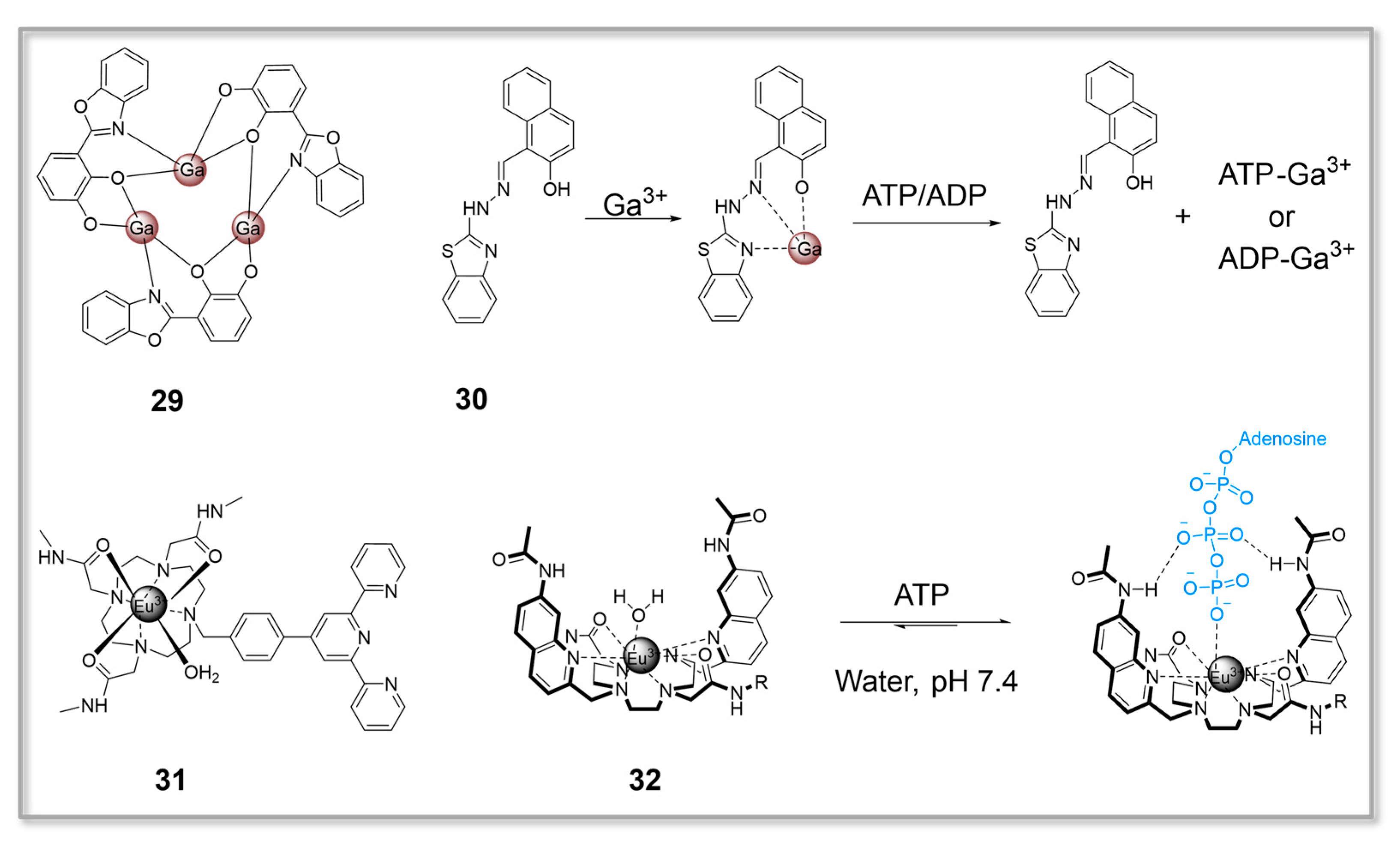

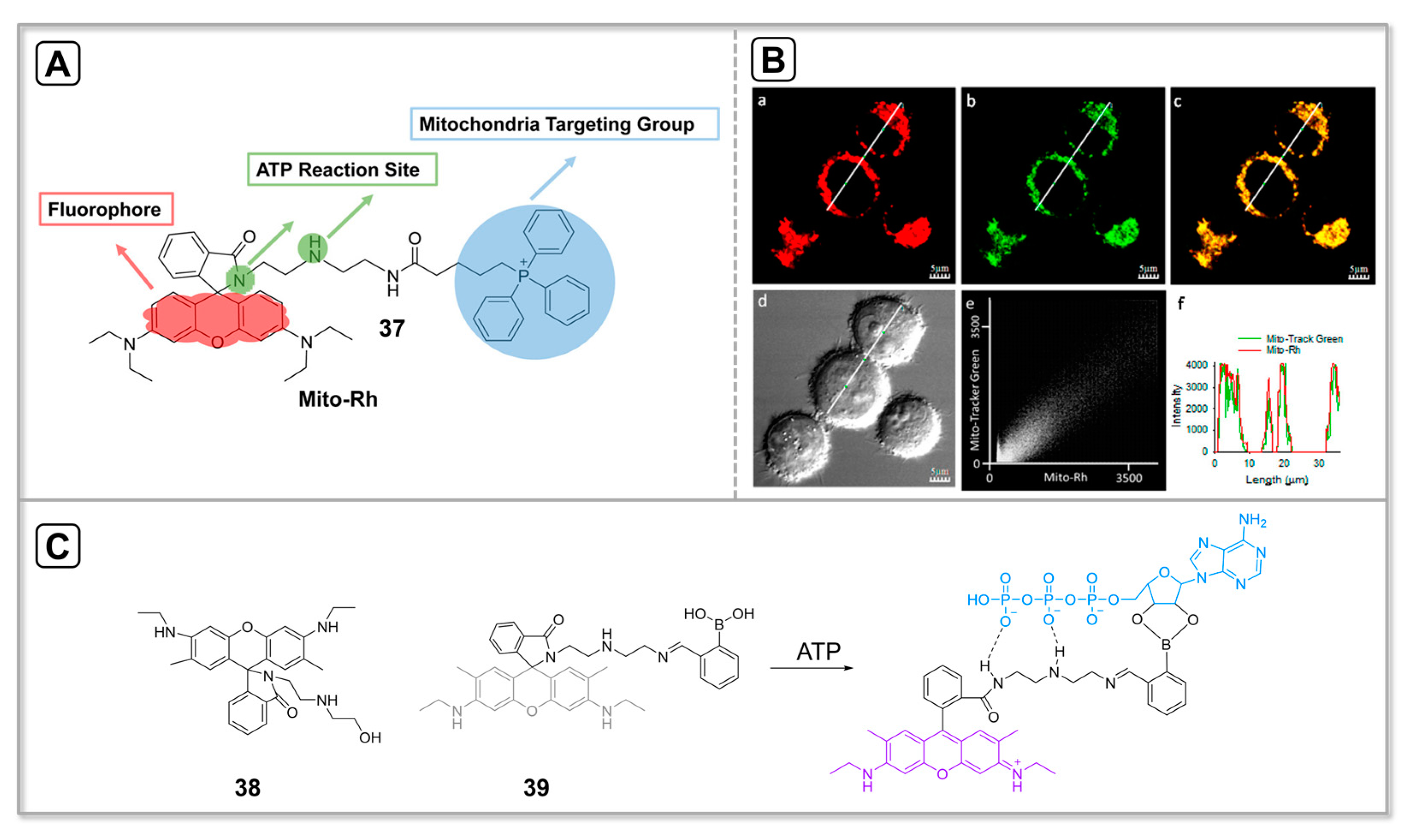
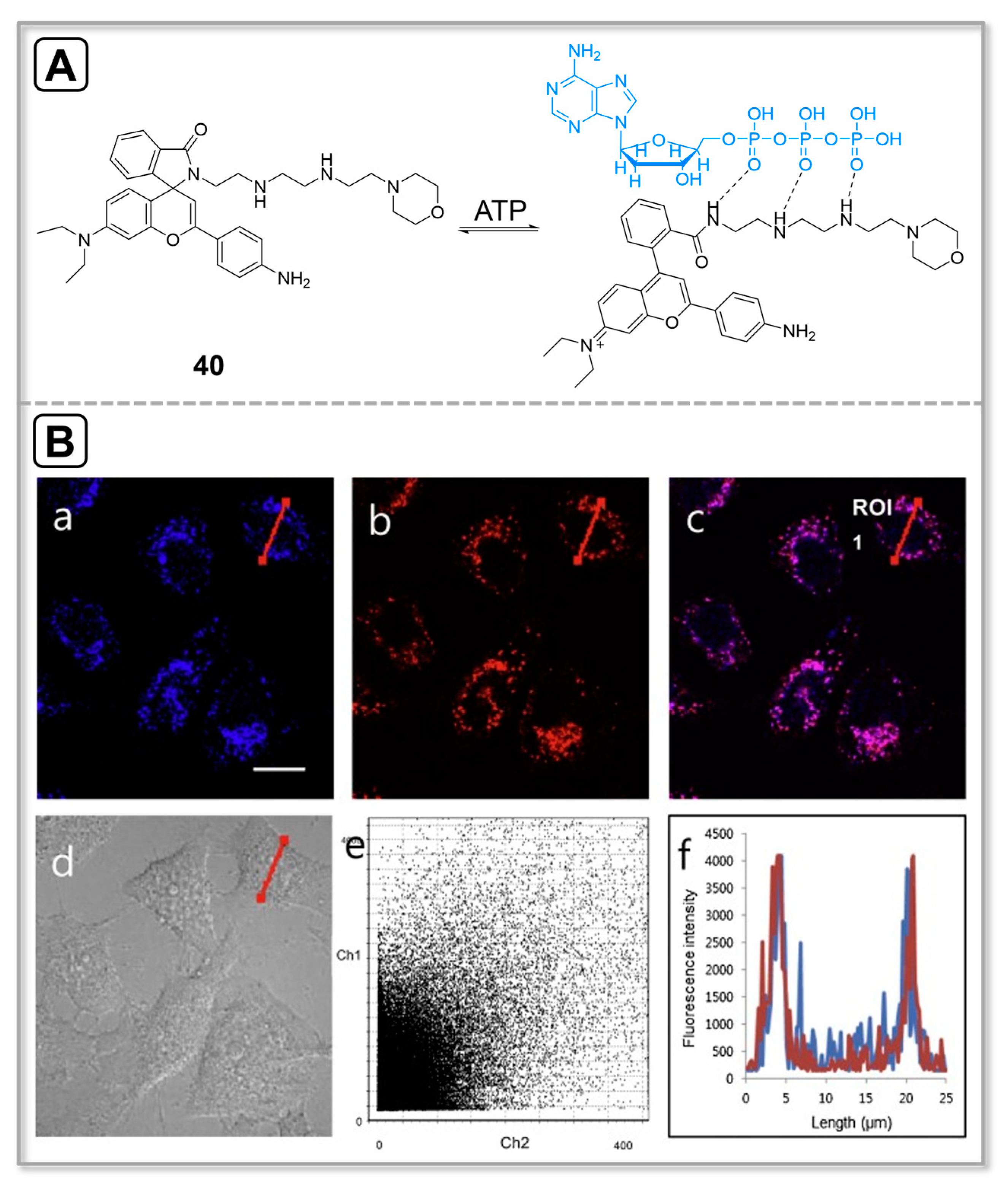
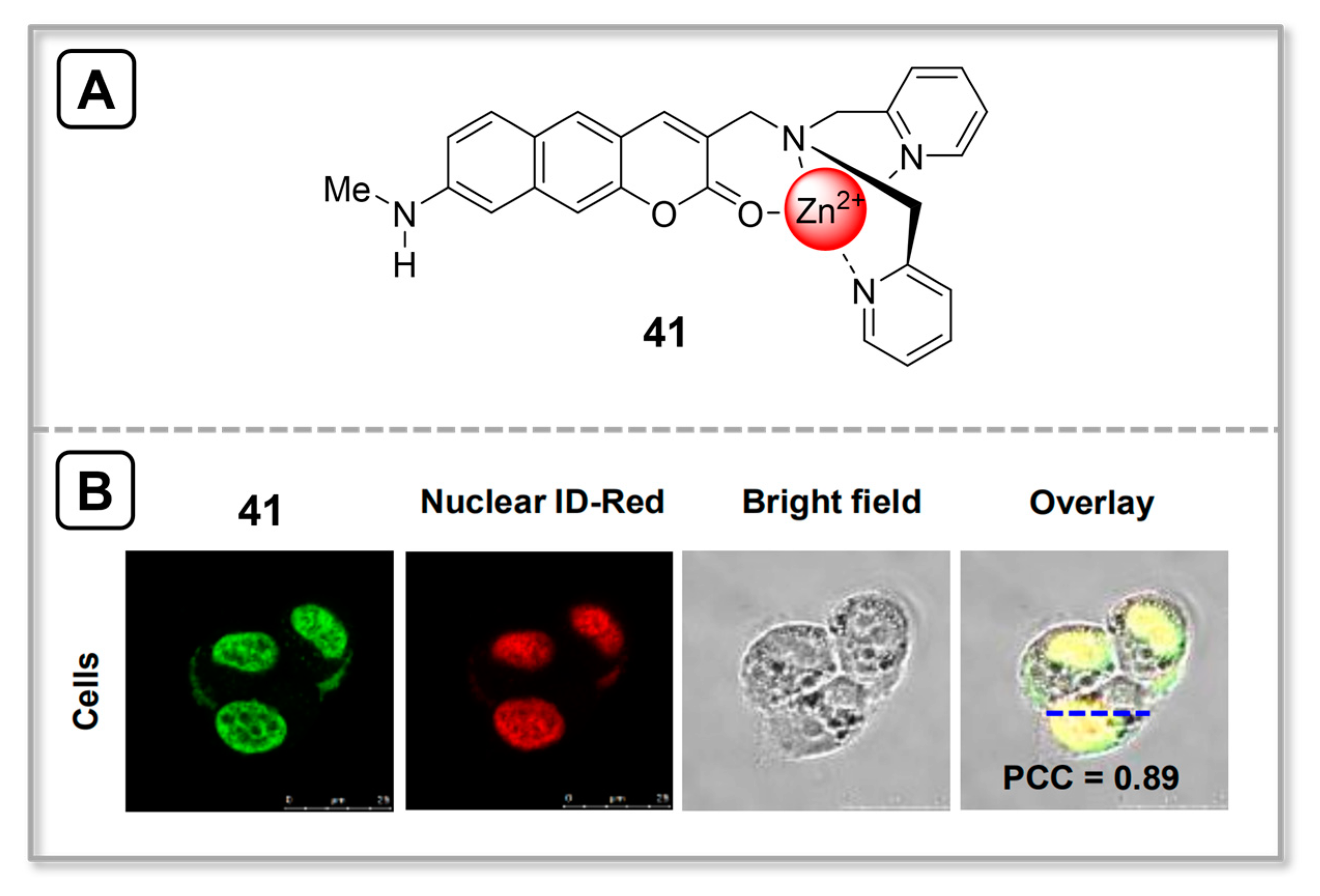
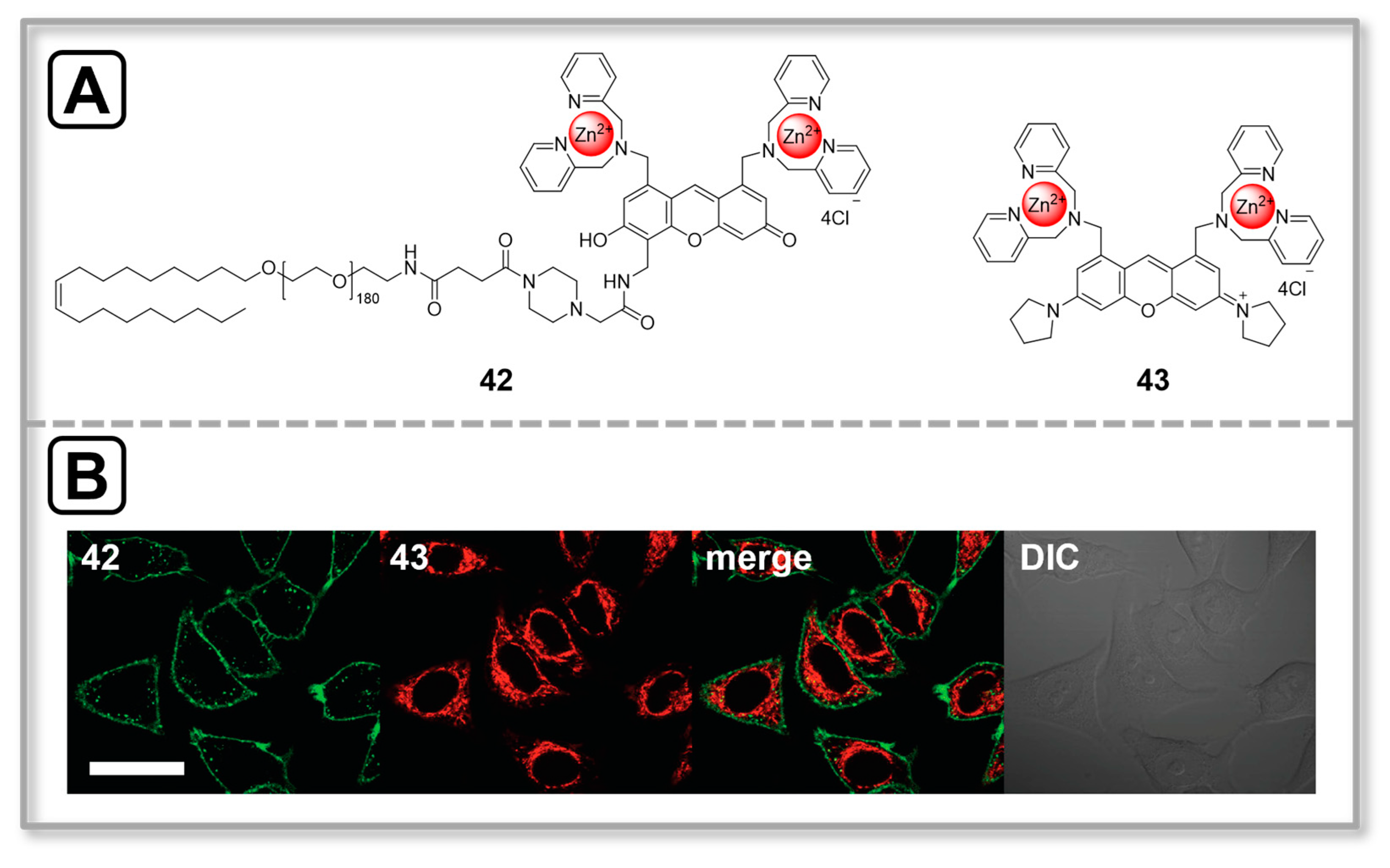
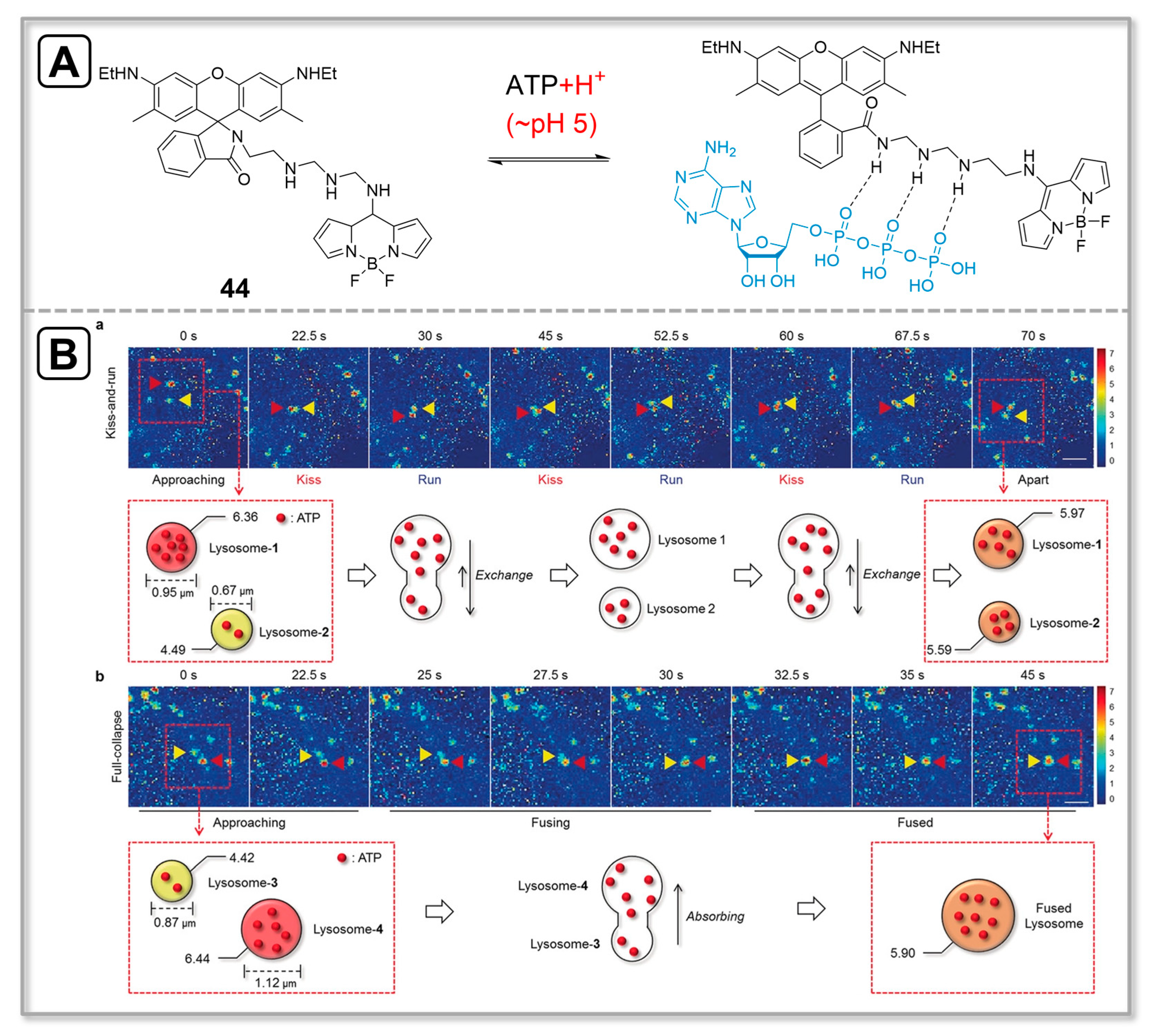

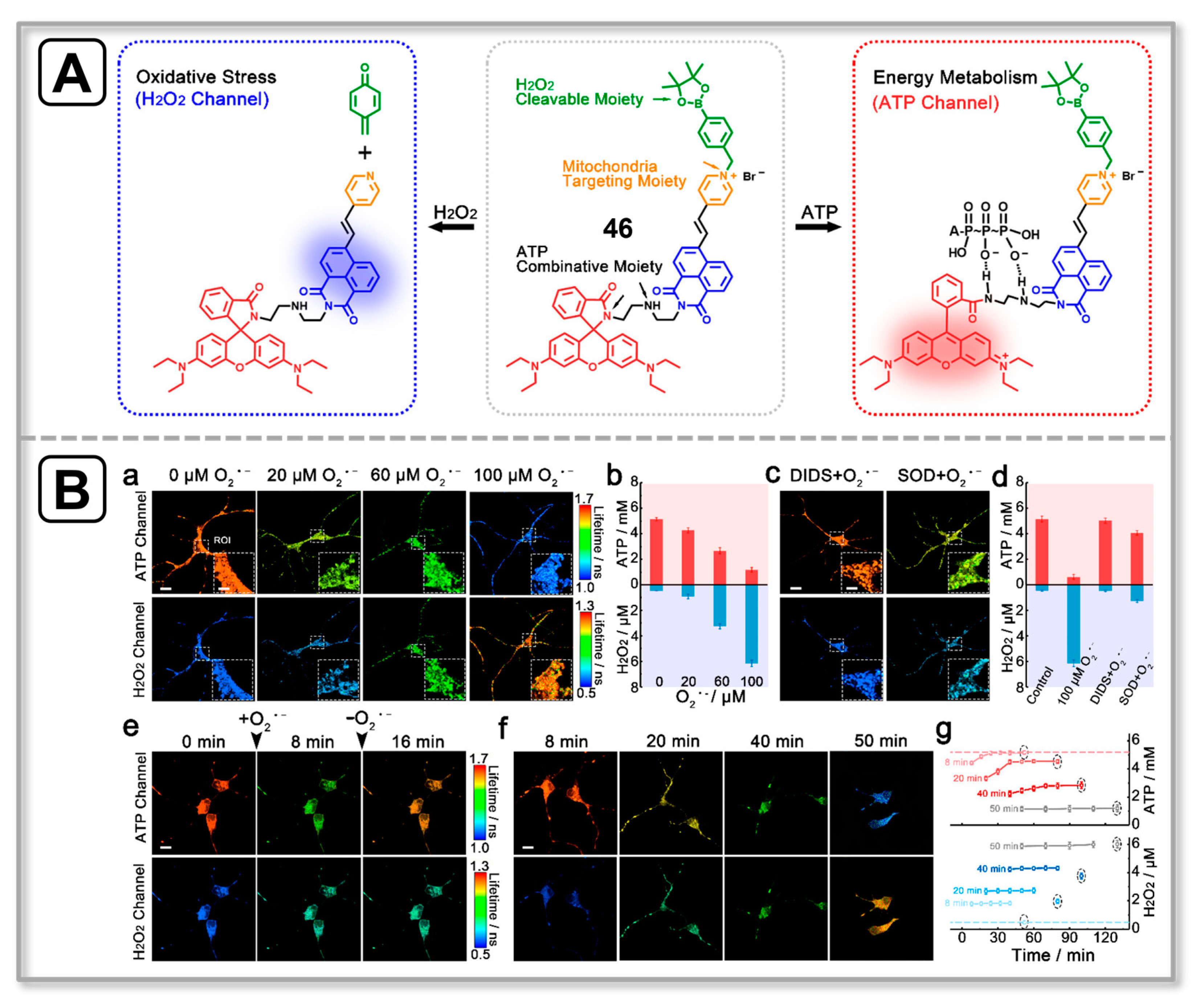

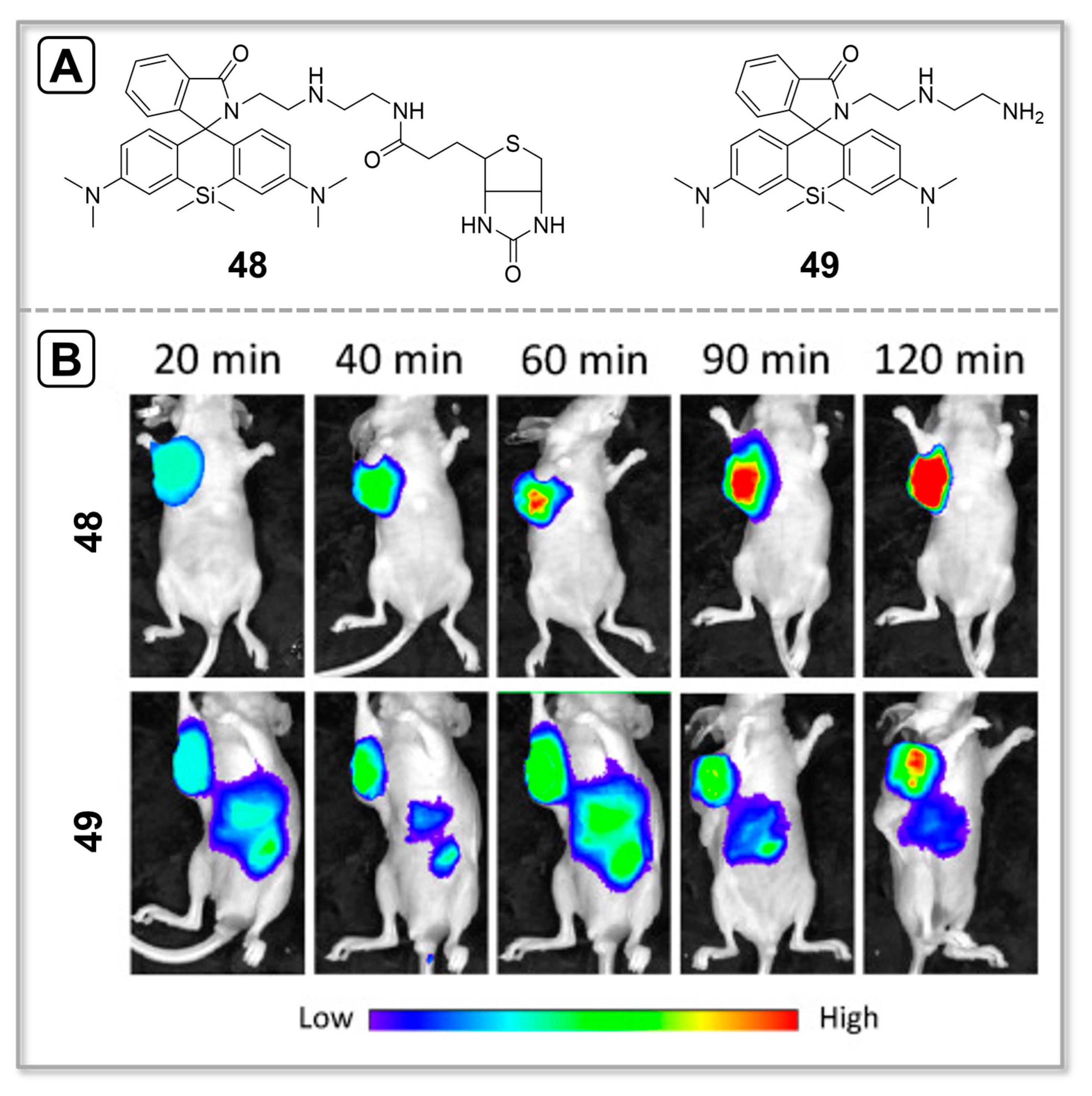
| Probe | Fluorophore | λex/λem (nm) | Detection Type | ATP Detection Limit | ATP Detection Range (mM) | Analyte | Ref. |
|---|---|---|---|---|---|---|---|
| 1 | Rhodamine | 520/583 | Fluorescence enhancement | 2.5 × 10−8 M | 1.0 × 10−4–2.0 × 10−1 | ATP | [51] |
| 2 | Rhodamine, 1,8-naphthalimide | 420/530, 580 | Ratiometric | 1.0 × 10−4 M | 0–50 | ATP | [52] |
| 3 | Rhodamine | 500/560, 624 | Ratiometric | Not determined | 2.0–9.0 | ATP | [53] |
| 4 | Rhodamine | 660/700, 780 | Ratiometric | Not determined | 0–3.0 | ATP, H+ | [54] |
| 5 | Pyrene | 345/375, 487 | Ratiometric | Not determined | 0–2.0 × 10−1 | ATP, GTP | [4] |
| 6 | Naphthoimidazolium | 326/~460 | Fluorescence enhancement | Not determined | 0–6.0 × 10−2 | ATP, GTP | [55] |
| 7 | Piperazine–anthracene | 376/402, 422 | Fluorescence enhancement | 7 × 10−6 M | 0–1.0 × 10−1 | H+, ATP | [56] |
| 8 | Naphthalene | 290/386 | Fluorescence enhancement | 8.44 × 10−6 M | 0–1.0 × 10−1 | ATP | [57] |
| 9 | 1,8-naphthalimide | 410/540 | Fluorescence enhancement | Not determined | 0–1.4 × 10−2 | ATP | [58] |
| 10 | Tetraphenylethene | 335/463 | Fluorescence enhancement | Not determined | 0–6.0 × 10−2 | ATP | [59] |
| 11 | Thiazole orange | 520/580 | Fluorescence enhancement | Not determined | 0–8.0 × 10−2 | ATP | [60] |
| 12 | Tetraphenylethylene | 365/500 | Fluorescence enhancement | 7.5 × 10−8 M | 1–4.0 × 10−3 | ATP | [61] |
| 13 | Triphenylamine-pyridinium | 427/613 | Fluorescence enhancement | Not determined | 0–3.0 × 10−1 | ATP | [62] |
| 14 | Triphenylamine-pyridinium | 432/609 | Fluorescence enhancement | Not determined | 0–3.0 × 10−1 | ATP | [62] |
| 15 | Triphenylamine-pyridinium | 437/614 | Fluorescence enhancement | Not determined | 0–3.0 × 10−1 | ATP | [62] |
| 16 | Triphenylamine-pyridinium | 451/614 | Fluorescence enhancement | 0.3 ppm | 0–3.0 × 10−1 | ATP | [62] |
| Probe | Fluorophore | λex/λem (nm) | Detection Type | ATP Detection Limit | ATP Detection Range (mM) | Analyte | Ref. |
|---|---|---|---|---|---|---|---|
| 17 | Anthracene | 380/460 | Fluorescence enhancement | Not determined | 0–1.8 × 10−2 | ATP | [64] |
| 18 | Xanthene | 488/522 | Fluorescence enhancement | 1.0 × 10−6 M | 0–1.0 × 10−2 | ATP | [65] |
| 19 | Xanthene, coumarin | 341/454, 525 | Ratiometric | Not determined | 0–5.0 × 10−3 | [ATP], [ATP] + [ADP] | [66] |
| 20 | Xanthene, coumarin | 414/477, 525 | Ratiometric | Not determined | 0–5.0 × 10−3 | [ATP], [ATP] + [ADP] | [66] |
| 21 | Perylene diimide | 500/559 | Fluorescence enhancement | Not determined | 0–1.0 × 10−1 | ATP | [67] |
| 22 | Coumarin | 400/500 | Fluorescence enhancement | 8.4 × 10−9 M | 0–5.0 × 10−3 | ATP | [68] |
| 23 | Fluorescein | 420/527 | Fluorescence quenching | 5.0 × 10−7 M | 0–1.0 × 10−2 | ATP, Zn+ | [69] |
| 24 | Pyrene | 346/383 | Fluorescence enhancement | Not determined | 1.0 × 10−1 | Nucleotides | [70] |
| 25 | Pyrene | 350/390, 482 | Ratiometric | Not determined | 0–3.0 × 10−2 | ATP, ADP, AMP | [71] |
| 26 | 1,8-naphthalimide | 451/541 | Fluorescence enhancement | 8.5 × 10−9 M | 0–1.0 × 10−1 | ATP, Cu2+ | [73] |
| 27 | Rhodamine | 510/575 | Fluorescence quenching | 1.0 × 10−6 M | 0–1.0 × 10−2 | ATP, Cu2+ | [77] |
| 28 | Benzothiazole, xanthenes | 380/434, 595 | Ratiometric | 8.0 × 10−8 M | 0–1.0 × 10−2 | ATP, Cu2+ | [78] |
| 29 | 2-(2′,3′-dihydroxyphenyl)benzoxazole-Ga3+ complex | 360/461 | Fluorescence enhancement | 5.49 × 10−7 M | 1.0 × 10−3–1.0 × 10−2 | ATP, Ga3+ | [79] |
| 30 | Naphthol-Ga3+ complex | 440/518 | Fluorescence quenching | Not determined | 0–2.75 × 10−2 | Ga3+, ATP, ADP | [80] |
| 31 | Eu3+ | 335/591, 615 | Fluorescence enhancement | 8.87 × 10−6 M | 0–2.5 × 10−2 | ATP | [81] |
| 32 | Eu3+ | 330/688, 697 | Fluorescence enhancement | Not determined | 0–3.0 | ATP | [82] |
| Probe | Fluorophore | λex/λem (nm) | Detection Type | ATP Detection Limit | ATP Detection Range (mM) | Analyte | Ref. |
|---|---|---|---|---|---|---|---|
| 33 | Polythiophene | 445/529 | Fluorescence quenching | 1.0 × 10−8 M | 0–5 × 10−1 | ATP | [84] |
| 34 | Polythiophene | 410/520 | Fluorescence quenching | 3.6 × 10−11 M | 0–7.5 × 10−4 | ATP | [85] |
| 35 | Polythiophene | 410/524 | Fluorescence quenching | 2.7 × 10−8 M | 0–2.5 × 10−3 | ATP | [86] |
| 36 | Polythiophene, coumarin | 300/410, 568 | Ratiometric | 2.9 × 10−8 M | 0–2.8 × 10−2 | ATP | [87] |
| Probe | Fluorophore | λex/λem (nm) | Detection Type | Application | Targeting | Analyte | Ref. |
|---|---|---|---|---|---|---|---|
| 37 | Rhodamine | 520/583 | Fluorescence enhancement | Cell imaging | Mitochondria-targeting | ATP | [88] |
| 38 | Rhodamine | 527/557 | Fluorescence enhancement | Cell imaging | Mitochondria-targeting | ATP | [89] |
| 39 | Rhodamine | 510/558 | Fluorescence enhancement | Cell imaging | Mitochondria-targeting | ATP | [90] |
| 40 | Rhodamine | 480/634 | Fluorescence enhancement | Cell imaging | Lysosome-targeting | ATP | [92] |
| 41 | Benzocoumarin | 400/595 | Fluorescence enhancement | Cell imaging | Nucleus-targeting | ATP | [94] |
| 42 | Xanthene | 450/528 | Fluorescence enhancement | Cell imaging | Plasma-membrane-surface-targeting | ATP | [96] |
| 43 | Xanthene | 543/590 | Fluorescence enhancement | Cell imaging | Mitochondria-targeting | ATP | [96] |
| 44 | Rhodamine, BODIPY | 403/454, 557 | Ratiometric | Cell imaging | Lysosome-targeting | ATP, H+ | [99] |
| 45 | Rhodamine | 540/580 | Fluorescence enhancement | Cell imaging | NO | NTR, ATP | [102] |
| 46 | Rhodamine | 710/590 | Fluorescence enhancement | Cell imaging, Zebrafish imaging | Mitochondria-targeting | H2O2, ATP | [107] |
| 47 | Rhodamine | 520/587 | Fluorescence enhancement | Cell imaging | NO | ATP, ONOO− | [111] |
| 48 | Rhodamine | 640/675 | Fluorescence enhancement | Cell imaging, Mice imaging | Tumor-targeting | ATP | [113] |
| 49 | Rhodamine | Not determined | Fluorescence enhancement | Cell imaging, Mice imaging | NO | ATP | [113] |
Disclaimer/Publisher’s Note: The statements, opinions and data contained in all publications are solely those of the individual author(s) and contributor(s) and not of MDPI and/or the editor(s). MDPI and/or the editor(s) disclaim responsibility for any injury to people or property resulting from any ideas, methods, instructions or products referred to in the content. |
© 2023 by the authors. Licensee MDPI, Basel, Switzerland. This article is an open access article distributed under the terms and conditions of the Creative Commons Attribution (CC BY) license (https://creativecommons.org/licenses/by/4.0/).
Share and Cite
Gu, Q.-S.; Li, T.; Liu, T.; Yu, G.; Mao, G.-J.; Xu, F.; Li, C.-Y. Recent Advances in Design Strategies and Imaging Applications of Fluorescent Probes for ATP. Chemosensors 2023, 11, 417. https://doi.org/10.3390/chemosensors11070417
Gu Q-S, Li T, Liu T, Yu G, Mao G-J, Xu F, Li C-Y. Recent Advances in Design Strategies and Imaging Applications of Fluorescent Probes for ATP. Chemosensors. 2023; 11(7):417. https://doi.org/10.3390/chemosensors11070417
Chicago/Turabian StyleGu, Qing-Song, Ting Li, Ting Liu, Guo Yu, Guo-Jiang Mao, Fen Xu, and Chun-Yan Li. 2023. "Recent Advances in Design Strategies and Imaging Applications of Fluorescent Probes for ATP" Chemosensors 11, no. 7: 417. https://doi.org/10.3390/chemosensors11070417




